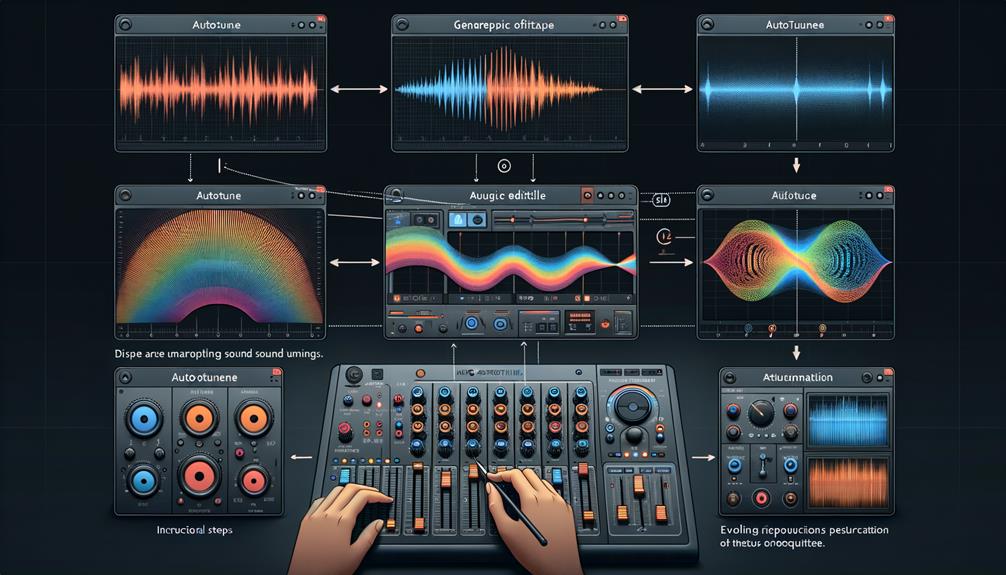No products in the cart.
Have you ever wished you could achieve professional autotune effects in Audacity, despite it not having a built-in autotune feature?
While Audacity doesn’t come with autotune capabilities, there’s a way to add this functionality using the GSnap plugin.
The process involves a few steps, but once you have it set up, you can start fine-tuning your vocals with ease.
Stay tuned to discover how you can bring autotune to your Audacity projects and take your audio editing skills to the next level.
Contents
hide
Key Takeaways
- GSnap, MAutoPitch, and Graillon 2 are popular autotune plugins for Audacity.
- To install autotune plugins, download the software from official websites and extract the contents.
- Copy the plugin folders into the Audacity Plug-Ins folder to make them available in Audacity.
- Enable the plugins in Audacity by going to the Effects or Plugin Manager menu.
Installing GSnap Autotune Plugin
To install the GSnap Autotune plugin, follow these steps:
- Download the software from the official website and extract the contents of the ZIP folder.
- Once the download is complete, locate the ZIP folder and extract its contents to reveal the GSnap plugin files.
- After extracting the files, locate the Audacity Plug-Ins folder on your computer.
- Copy the GSnap folder contents and paste them into the Audacity Plug-Ins folder. This ensures that Audacity recognizes the GSnap plugin when it starts up.
Now that the GSnap plugin is installed, proceed with the following steps:
- Launch Audacity and navigate to the Edit menu.
- From there, select Preferences.
- Click on the Effects tab.
- Check the box next to ‘Rescan VST effects next time Audacity is started.’
- Click OK to save the changes. This step ensures that Audacity recognizes the newly installed GSnap plugin.
With the GSnap plugin successfully installed, you’re now ready to start using the auto-tune effect on your vocals in Audacity. This process allows you to achieve the desired auto-tuned vocal effect with ease.
Enabling GSnap in Audacity
When launching Audacity, navigate to the Edit menu and select Preferences to enable GSnap for use in your audio projects.
Follow these steps to enable GSnap in Audacity:
- In the Preferences window, click on the Effects tab. This is where you can manage and enable various plug-ins for Audacity, including GSnap.
- Check the box next to ‘Rescan VST effects next time Audacity is started.’ This ensures that Audacity recognizes and includes the GSnap autotune plugin in its list of available effects.
- Click OK to save the changes and close the Preferences window. By doing this, you have successfully enabled GSnap in Audacity, allowing you to utilize this free plug-in called GSnap to apply autotune effects to your audio recordings.
Once you have completed these steps, GSnap will be ready for use in your Audacity projects. You can now proceed to apply autotune effects to your audio tracks using this powerful plug-in.
Auto-Tuning Your Vocals

Achieve professional-quality vocal tuning by effectively utilizing the GSnap plugin in Audacity, enhancing the overall sound of your recordings. To auto-tune your vocals, follow these steps:
| Steps | Description |
|---|---|
| 1. Install GSnap plugin | Download the plugin from the official website and add the files to the Audacity Plug-Ins folder. |
| 2. Enable GSnap in Audacity | Navigate to the Edit menu, select Preferences, and check the box for ‘Rescan VST effects next time Audacity is started.’ |
| 3. Import or record vocals | Import or record your vocals in Audacity. |
| 4. Apply GSnap effect | Highlight the vocals, go to the Effect menu, select GSnap, adjust the settings, preview, and click Apply to save the changes. |
| 5. Experiment and save | Experiment with different settings in GSnap, use the Preview button to listen before applying the effect, and remember to save your project frequently. |
Using MAutoPitch Plugin
Consider utilizing the MAutoPitch plugin in Audacity to enhance the pitch and formant of your recorded vocals. To get started, download and install the MAutoPitch plugin from the official website of MeldaProduction.
Next, open Audacity and go to the Effects menu, then select Add/Remove Plug-ins. Enable the MAutoPitch plugin to make it available as an effect in Audacity.
Once the plugin is installed and enabled, import or record your vocals in Audacity and highlight the section you want to auto-tune. Then, go to the Effects menu, choose MAutoPitch, and adjust the settings such as pitch correction and formant shift.
Utilizing the MAutoPitch plugin in Audacity provides a convenient way to add an autotune effect to your audio files. By following the step-by-step process and adjusting the pitch and formant parameters, you can achieve the desired autotune feature without the need for complex software or additional plugins.
This streamlined approach allows you to seamlessly integrate autotune into your vocal recordings, enhancing the overall quality and performance of your audio projects.
Applying Graillon for Autotune


To apply Graillon for autotune in Audacity, follow these steps:
- Download and install Graillon 2 from the Auburn Sounds website.
- Open Audacity and go to the Effect > Plugin Manager to enable Graillon 2.
- Record or import your vocal track into Audacity for autotuning.
- Access Graillon 2 from the Effect tab and adjust settings like Enable and Inertia for pitch correction.
- Use the Preview button to listen to the autotune effect.
- Click Apply to save the changes.
After downloading Graillon 2, you need to locate the Audacity Plug-Ins folder on your computer. Follow these steps:
- Open the File Explorer window.
- Copy the Graillon 2 file into the Audacity Plug-Ins folder.
- This allows Audacity to recognize and access the Graillon 2 plugin for autotuning vocals.
When applying Graillon for autotune, you can precisely adjust the pitch of audio to achieve the desired effect. This plugin provides an innovative and user-friendly approach to autotuning vocals in Audacity, enhancing the overall sound quality of your recordings.
Whether you’re a beginner or an experienced user, Graillon 2 offers a free and accessible option for autotuning within Audacity, allowing you to create professional-sounding tracks with ease.
Frequently Asked Questions
Can I Autotune Using Audacity?
Yes, you can autotune using Audacity. It offers vocal pitch correction, digital modulation, and sound editing for music production. Audacity enables vocal enhancement, pitch correction, audio processing, voice tuning, and sound engineering through precise audio manipulation.
What Is the Best Autotune Plugin for Audacity?
For vocal recording and music production in Audacity, the best autotune plugin is MAutoPitch. It supports all mainstream instruments and vocals, providing precise pitch adjustment, vocal enhancement, and sound manipulation for digital music.
How Do I Add a Tune in Audacity?
To add a tune in Audacity for vocal editing, pitch adjustment, and sound manipulation, import or record vocals, highlight them, and apply GSnap effects. Experiment with settings for melody correction and voice modulation to enhance your audio.
What Is the Pitch Correction Plugin for Audacity?
The pitch correction plugin for Audacity, like GSnap, allows you to enhance vocal editing, manipulate audio, and correct pitch, thus enhancing vocal processing, sound correction, and music production. It’s a powerful tool for audio tuning and sound engineering.
Conclusion
Now you have the tools and knowledge to achieve autotune effects in Audacity.
By installing the GSnap plugin, enabling it in Audacity, and adjusting the settings, you can easily auto-tune your vocals to perfection.
Additionally, you can explore other autotune plugins such as MAutoPitch and Graillon to further enhance your audio recordings.
With these techniques, you can achieve professional-sounding autotune effects right in Audacity.




